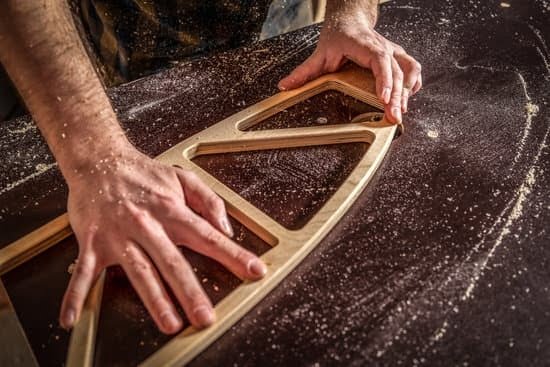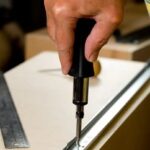Woodworking joints are an essential aspect of creating strong and durable wooden structures, furniture, and crafts. In this comprehensive guide, we will delve into the world of woodworking joints, starting with the basics and gradually moving on to more advanced techniques. Whether you are a beginner just starting out in woodworking or an experienced woodworker looking to refine your skills, understanding how to cut woodworking joints is crucial for mastering this craft.
The art of cutting woodworking joints is not only about creating functional connections but also about achieving precision and craftsmanship. From dovetail joints to mortise and tenon joints, each type has its own unique method of cutting that requires practice and attention to detail. With the right tools and techniques, you can elevate your woodworking projects to a professional level.
In this article, we will explore the essential tools needed for cutting woodworking joints, provide a step-by-step guide for mastering dovetail joints, discuss the techniques and tips for cutting mortise and tenon joints, as well as explore other popular types of joints such as finger joints, rabbet joints, half-lap joints. Additionally, we will address common mistakes that woodworkers make when cutting joints and offer troubleshooting solutions.
Whether you are a novice or seasoned woodworker, there is valuable information here to enhance your skills in creating beautifully crafted woodworking joints.
Essential Tools for Cutting Woodworking Joints
Woodworking requires a variety of tools, but when it comes to cutting woodworking joints, having the right tools is essential for achieving precision and accuracy. Whether you are a beginner or a seasoned woodworker, having the right tools will make the process of cutting woodworking joints much smoother and more efficient. Here is a comprehensive guide to essential tools for cutting woodworking joints:
Backsaw
A backsaw is an essential tool for making accurate and clean cuts when cutting joinery. Its rigid spine ensures straight and precise cuts, making it perfect for cutting dovetail, finger, and rabbet joints.
Chisels
Chisels are used for paring and fine-tuning the surfaces of the joint once they have been roughed out by saws or other cutting tools. They come in various sizes and shapes to accommodate different joint styles.
Router
A router is a versatile tool that can be used with different bits to create a wide range of woodworking joints, including mortise and tenon, rabbet, and half-lap joints. It is an essential power tool for any woodworker looking to expand their joinery capabilities.
These essential tools will set you on the right path toward mastering the art of cutting woodworking joints. Investing in high-quality tools and maintaining them properly will ensure that your woodworking projects are not only successful but also enjoyable. Understanding how to cut woodworking joints is important, but having the right tools will make the process much simpler and more satisfying.
Step-by-Step Guide on How to Cut Dovetail Joints
Dovetail joints are a classic woodworking joint known for their strength and decorative appeal. This type of joint is commonly used in drawer construction, cabinets, and furniture making. Mastering the art of cutting dovetail joints requires precision and attention to detail. In this section, we will provide a step-by-step guide on how to cut dovetail joints and share some tips for achieving clean and professional results.
Understanding Dovetail Joints
Before delving into the step-by-step guide, it’s important to have a good understanding of what dovetail joints are and how they work. Dovetail joints consist of a series of pins and tails that interlock with each other, creating a strong bond between two pieces of wood. The unique shape of the pins and tails prevents the joint from pulling apart, making it ideal for applications where strength is crucial.
Tools and Materials
To cut dovetail joints, you will need a few essential tools and materials. These include a dovetail saw, chisels, marking gauge, dovetail jig (optional), pencil or marking knife, and the wood pieces you will be joining together. Additionally, having a quality workbench with clamps to secure your workpieces is essential for achieving precise cuts.
Step-by-Step Guide
1. Marking: Begin by marking out where the tails will be cut on one piece of wood and where the corresponding pins will be cut on the adjoining piece.
2. Cutting: Use a dovetail saw to carefully cut along the marked lines to create the pins and tails.
3. Chiseling: With the help of chisels, carefully remove the waste wood between the pins/tails until they fit snugly together.
4. Test Fit: Once the pins and tails have been cut, test fit them together to ensure they align properly without gaps.
5. Final Adjustments: Make any necessary adjustments using chisels or a block plane to achieve a tight-fitting joint.
By following this step-by-step guide on how to cut dovetail joints, you can master this classic woodworking joint and incorporate it into your woodworking projects with confidence. With practice and patience, you’ll be able to create strong and visually appealing dovetails that enhance your craftsmanship.
The Art of Cutting Mortise and Tenon Joints
Mortise and tenon joints are classic woodworking joints that have been used for centuries due to their strength and durability. In this section, we will explore the techniques and tips for cutting mortise and tenon joints, providing you with the knowledge to master this essential woodworking skill.
Understanding Mortise and Tenon Joints
Before diving into the techniques for cutting mortise and tenon joints, it’s important to understand the basic concept of these joints. A mortise is a slot or cavity cut into a piece of wood, while a tenon is a projection on the end of a piece of wood that is designed to fit into the mortise. This creates a strong, interlocking connection between two pieces of wood.
Tools and Materials
To cut mortise and tenon joints, you will need some essential tools and materials. These include a chisel, marking gauge, combination square, tenon saw, and mallet. Additionally, having access to a table saw or bandsaw can make the process easier and more precise. It’s important to use sharp tools to ensure clean cuts and accuracy in your joinery work.
Techniques for Cutting Mortise and Tenon Joints
The process of cutting mortise and tenon joints involves several steps, including marking out the joint, cutting the mortises and tenons, fitting the joint together, and finally gluing or securing it in place. By following proper measurement techniques with your tools in hand – and ensuring that your tools are sharp – you can achieve high precision in crafting these sturdy woodwork connections.
By understanding how these classic woodworking joints work, acquiring the necessary tools for precision workmanship – and mastering specific methods like using sharp chisels – you’ll be well on your way towards becoming adept at creating dependable furniture pieces solidified through reliable mortar-and-tenon joinery.
Tips for Cutting Finger Joints
Woodworking joints are an essential part of any woodworking project, and mastering the art of cutting them is crucial for achieving a professional finish. One of the most popular types of woodworking joints is the finger joint, also known as a box joint. This type of joint is commonly used in making boxes, drawers, and other similar projects. In this section, we will discuss some tips for cutting finger joints with precision and accuracy.
First and foremost, it is important to ensure that you have the right tools for cutting finger joints. You will need a table saw equipped with a dado stack or a router table with a straight bit to make these cuts. Additionally, using a jig specifically designed for cutting finger joints can help you achieve more precise and consistent results.
When setting up your tools for cutting finger joints, it’s crucial to pay attention to the measurements and spacing between each cut. The key to achieving a tight-fitting finger joint lies in maintaining uniformity in the size and spacing of the fingers. Taking the time to carefully set up your tools and make test cuts can save you from costly mistakes later on.
Another important tip for cutting finger joints is to pay attention to the orientation of your workpiece as you make your cuts. Ensuring that each piece is properly oriented before making the cuts can help prevent errors and ensure that all your pieces fit together seamlessly when assembled.
| Tip | Description |
|---|---|
| Use a dedicated jig | Invest in or build a quality jig specifically designed for cutting finger joints to achieve precise and accurate results. |
| Maintain consistency | Ensure uniformity in the size and spacing of the fingers by carefully setting up your tools and making test cuts before proceeding. |
| Pay attention to workpiece orientation | Double-check that each workpiece is properly oriented before making cuts to prevent errors in assembly. |
By following these tips and taking the time to practice, you can improve your skills in cutting finger joints with precision and accuracy for your woodworking projects.
Exploring the World of Rabbet Joints
Rabbet joints are a versatile and commonly used joint in woodworking. They are often used to join two pieces of wood at a right angle, creating a clean and seamless connection. In this section, we will delve into the world of rabbet joints and provide a comprehensive guide on how to achieve clean cuts when working with this type of joint.
To create rabbet joints, you will need to use tools such as a table saw, router, or chisel. These tools allow you to cut precise and clean edges on the wood, ensuring that the joints fit together seamlessly. Additionally, having a reliable marking tool is essential for accurately measuring and marking the wood before making your cuts.
When cutting rabbet joints, it is crucial to pay attention to the depth and width of your cuts. Using a dado blade on a table saw or adjusting the depth of your router can help you achieve the perfect measurements for your rabbet joints. Taking your time and making incremental cuts can also prevent any errors and ensure that the joints fit together perfectly.
One common technique for achieving clean rabbet joints is using a sacrificial fence on your table saw. This helps to prevent tearout and ensures that the edges of the wood remain smooth and free from any splintering. Additionally, using sharp blades and cutting tools will result in cleaner cuts and ultimately improve the overall quality of your rabbet joints.
| Rabbet Joints Tips | Cutting Technique |
|---|---|
| Use sacrificial fence on table saw | Prevent tearout during cutting |
| Sharp cutting tools | Improve overall quality of joints |
Advanced Techniques for Cutting Half-Lap Joints
Cutting half-lap joints is an advanced woodworking technique that requires precision and accuracy. It involves cutting a slot in one piece of wood that allows another piece of wood to fit into it at a 90-degree angle, creating a strong and durable joint.
Mastering the art of cutting half-lap joints will take your woodworking skills to the next level and allow you to create beautifully crafted and sturdy furniture and structures. Here is a step-by-step guide on how to cut half-lap joints:
1. Measure and Mark: Use a measuring tape and pencil to mark the exact location where you want to cut the half-lap joint on both pieces of wood. Make sure the measurements are precise to ensure a tight fit.
2. Set Up Your Tools: You will need a table saw or a dado blade on a radial arm saw for this task. Set up the blade height and fence according to your measurements, ensuring that they are aligned accurately.
3. Cut the Joint: Carefully guide the wood through the saw, making sure to stay precisely on the marked lines. Take your time and use steady pressure to achieve clean and smooth cuts.
4. Test Fit: Once both pieces have been cut, test fit them together to check for any gaps or misalignment. Make any necessary adjustments with chisels or sandpaper until the joint fits snugly.
5. Glue and Clamp: Apply woodworking glue to the joint surfaces and clamp the pieces together firmly until the glue has dried completely.
By following these steps, you can master the art of cutting half-lap joints and take your woodworking skills to new heights. With practice and patience, you will be able to create strong and beautiful joints that elevate your woodworking projects to a professional level.
Common Mistakes to Avoid When Cutting Woodworking Joints
Cutting woodworking joints requires precision and attention to detail to ensure a strong and sturdy finished product. However, there are common mistakes that many beginners make when cutting woodworking joints. By being aware of these potential pitfalls, you can troubleshoot any issues that arise and find effective solutions to achieve the perfect joint.
One common mistake when cutting woodworking joints is rushing the process. It’s important to take your time and carefully measure and mark your cuts to ensure accuracy. Rushing through the process can result in poorly fitting joints that compromise the structural integrity of your workpiece. To avoid this mistake, use a combination square and marking gauge to accurately measure and transfer your layout lines.
Another mistake to avoid is using dull or improperly set cutting tools. Dull chisels or saw blades can result in rough or uneven cuts, making it difficult to achieve a tight-fitting joint. Ensure that your cutting tools are sharp and properly set before beginning the joinery process. Additionally, be sure to use the correct cutting tool for the specific type of joint you are attempting to create.
Lastly, failing to test-fit your joints before gluing and assembling them is a common mistake that can lead to frustration and wasted materials. Always perform test fits throughout the cutting process to ensure that everything aligns correctly before committing to permanent assembly. This will allow you to make any necessary adjustments before finalizing the joint.
By being mindful of these common mistakes and implementing effective solutions, you can troubleshoot any issues that arise during the woodworking joint cutting process, leading to well-crafted and sturdy finished products.
Conclusion
In conclusion, mastering the art of cutting woodworking joints requires patience, practice, and a good understanding of the various techniques and tools involved. Whether you are just starting out or looking to enhance your skills, the step-by-step guides provided in this article can serve as a valuable resource. From dovetail and mortise and tenon joints to finger joints, rabbet joints, and half-lap joints, each technique offers its own unique challenges and rewards.
There is no one-size-fits-all approach to cutting woodworking joints, as each project may require different techniques and tools. However, with the right knowledge and attention to detail, you can achieve precision and accuracy in your woodworking endeavors. It’s important to remember that practice makes perfect, so don’t be discouraged by initial setbacks. With perseverance and dedication, you can hone your skills and become proficient in the art of cutting woodworking joints.
Frequently Asked Questions
What Is the Best Tool for Cutting Wood Joints?
The best tool for cutting wood joints is a well-tuned and sharp hand saw or a chisel. These tools allow for precision and control when cutting different types of joints in wood.
What Instrument Do You Use to Cut a Joint?
To cut a joint, one typically uses a variety of hand tools such as saws, chisels, and mallets. Each tool serves a specific purpose in creating clean, precise cuts to form the joint that is needed for the woodworking project.
How Do You Cut a Joint by Hand?
Cutting a joint by hand requires patience, accuracy, and skill. Typically, one would mark the wood carefully with the specific measurements for the joint before using saws and chisels to remove the waste wood and form the joint. It’s important to work slowly and pay attention to details in order to achieve a perfect fit for the joint.

Hi everyone! I’m a woodworker and blogger, and this is my woodworking blog. In my blog, I share tips and tricks for woodworkers of all skill levels, as well as project ideas that you can try yourself.





